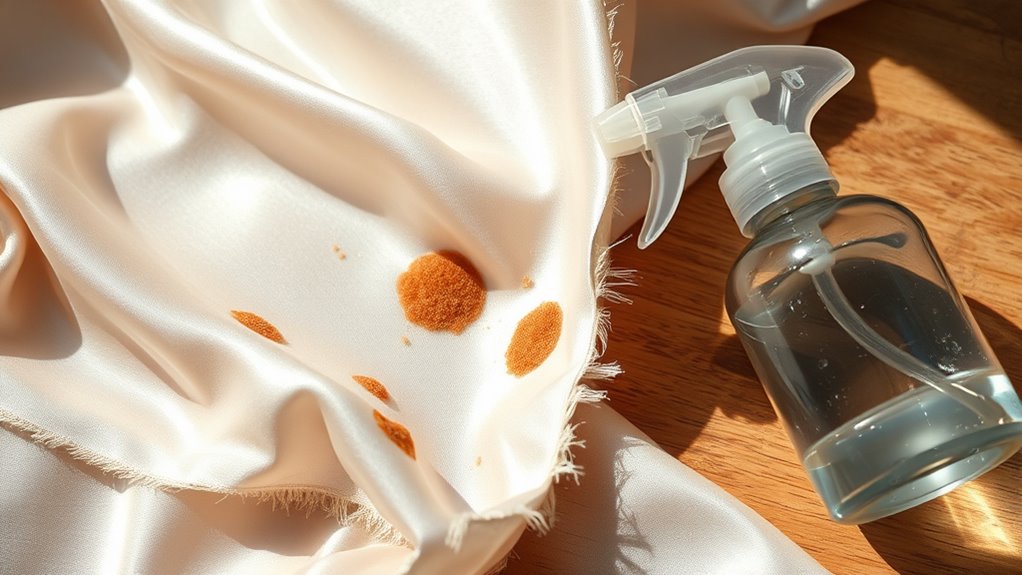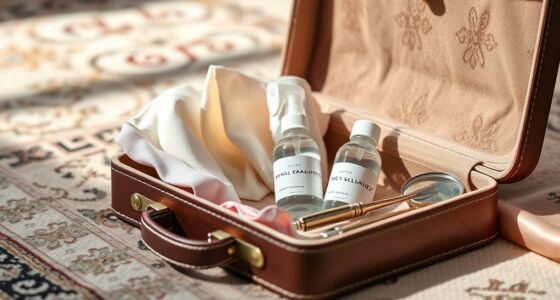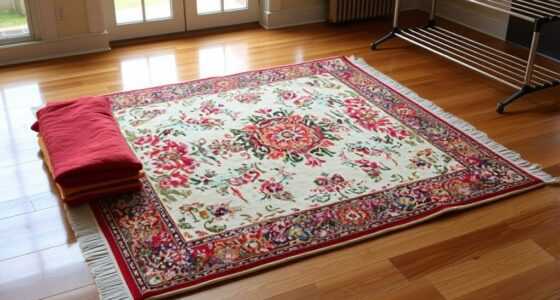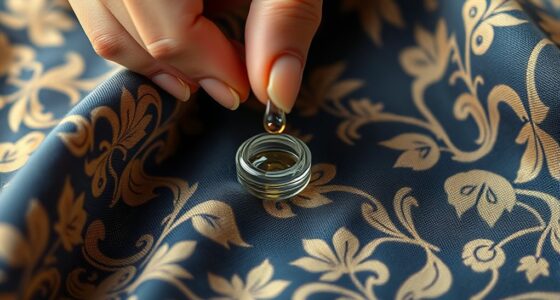Using the wrong cleaner on silk can easily damage its delicate fibers because pH levels matter. Acidic cleaners weaken the protein bonds, while alkaline ones cause fibers to swell and become brittle. Silk prefers a neutral or slightly acidic environment (pH 4.5-5.5). Harsh household cleaners can strip oils, dull shine, and cause fading. If you want to understand how pH balance protects silk and how to choose the right products, keep exploring.
Key Takeaways
- Wrong cleaners with improper pH levels can weaken silk fibers, leading to damage and reduced durability.
- Acidic cleaners (low pH) break down silk’s protein structure, causing discoloration and loss of shine.
- Alkaline cleaners (high pH) strip natural oils, making silk brittle and dull over time.
- Using non-neutral, harsh chemicals can leave residues that further harm silk’s delicate fibers.
- Maintaining proper pH balance (around 4.5-7) in cleaners preserves silk’s natural strength, shine, and longevity.
Understanding Ph Levels and Fabric Care
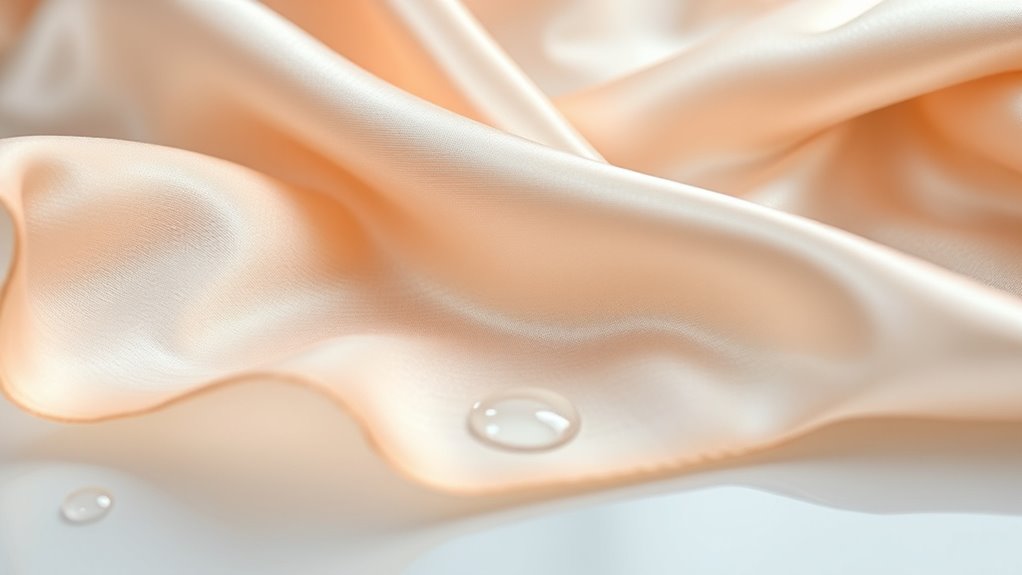
Understanding pH levels is essential for proper fabric care because different materials react uniquely to various cleaners. You need to know whether a cleaner is acidic, neutral, or alkaline to choose the right product for your silk. Acidic cleaners, with a low pH, can weaken delicate fibers, causing damage over time. Alkaline cleaners, with a high pH, can strip natural oils and dull the fabric’s shine. Neutral cleaners, around pH 7, tend to be gentler and safer for sensitive fabrics like silk. By paying attention to pH levels, you prevent problems like color fading, fiber weakening, or permanent damage. Proper performance tuning of cleaning methods can further enhance fabric longevity. Always check labels and opt for products specifically formulated for silk or delicate fabrics to preserve their softness and luster.
The Composition of Silk and Its Sensitivities

Silk’s delicate structure makes it highly sensitive to harsh cleaning agents and improper handling. It’s primarily composed of fibroin, a protein that forms a complex, lightweight fiber. Its smooth surface and natural amino acids give silk its lustrous sheen and strength, but these same features make it vulnerable. Exposure to aggressive chemicals can break down the protein chains, weakening the fiber and causing deterioration. Silk also contains natural oils and sericin, which help maintain its flexibility and luster. When exposed to unsuitable cleaners, these components can be stripped away or altered, leading to discoloration, loss of sheen, or fiber damage. Understanding silk’s composition helps you recognize why gentle, pH-balanced cleaners are essential to preserve its beauty and integrity over time. Additionally, using appropriate cleaning techniques can significantly extend the lifespan of silk garments.
How Acidic and Alkaline Cleaners Affect Silk

You need to understand how acidic and alkaline cleaners can harm silk fibers. Acidic cleaners can weaken or damage the delicate protein structure, while alkaline ones may cause fibers to swell or become brittle. Maintaining proper pH balance is vital to protect silk’s natural beauty and integrity.
Acid Damage to Fibers
Acidic cleaners can cause significant damage to silk fibers, weakening their delicate structure and leading to irreversible deterioration. When you use a highly acidic solution, it breaks down the fiber’s protein bonds, causing loss of strength and elasticity. Over time, this damage results in fibers becoming brittle and more prone to tearing. Acid exposure also causes discoloration, fading the natural sheen and vibrancy of silk. The damage isn’t always visible immediately, but it compromises the fabric’s integrity long-term. If you’re cleaning silk with an acidic product, you risk ruining the fabric permanently. To preserve silk’s beauty and durability, avoid cleaners with low pH levels and opt for gentle, pH-neutral solutions instead. Proper handling ensures your silk remains soft, shiny, and intact. Additionally, understanding color fidelity and how cleaning products impact it can help maintain silk’s vibrant appearance over time.
Alkaline Damage Effects
While acidic cleaners can weaken silk fibers, alkaline substances pose their own set of risks. When you use too much alkaline cleaner or one with a high pH, it can damage silk’s delicate structure. Alkaline solutions can cause fibers to swell, lose their luster, and become brittle over time. This damage happens because alkaline substances break down the natural proteins in silk, disrupting its smooth surface. If you’re not careful, repeated exposure can lead to permanent weakening or discoloration. Many harsh cleaners also strip away silk’s natural oils, making it more vulnerable to tearing or fraying. To protect your silk, avoid alkaline cleaners or use only those specifically designed for delicate fabrics, ensuring you don’t compromise its strength and beauty. Proper maintenance and understanding of the fabric’s sensitivities are crucial for preserving silk’s quality and longevity.
Ph Balance Importance
Maintaining the right pH balance is essential for preserving silk’s delicate structure and appearance. Using cleaners that are too acidic or alkaline can weaken fibers, cause discoloration, or lead to irreversible damage. Silk thrives in a neutral pH range, typically between 4.5 and 7.0. Here’s how pH levels impact silk:
| pH Level | Effect on Silk | Recommended Action |
|---|---|---|
| 3-4 | Highly acidic, damages fibers | Avoid acidic cleaners |
| 4.5-7 | Neutral, maintains silk integrity | Use pH-balanced, gentle cleaners |
| 8-9 | Slightly alkaline, risks damage | Minimize exposure, rinse thoroughly |
| 10+ | Highly alkaline, causes deterioration | Never use alkaline cleaners |
Keeping cleaners within the proper pH range ensures your silk stays soft, shiny, and strong.
Common Household Cleaners and Their Impact on Silk
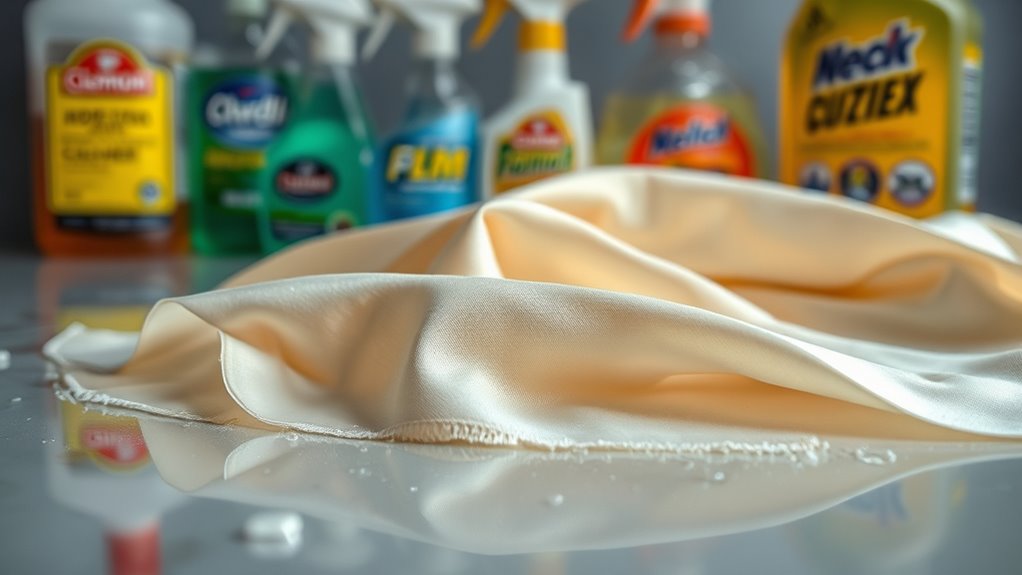
Many household cleaners contain harsh chemicals that can damage silk fibers. These substances can leave residues or stains that are difficult to remove and may weaken the fabric over time. Knowing which cleaners are safe helps you protect your delicate silk garments from unnecessary harm. Additionally, understanding how IRA withdrawals are taxed in various states can influence your overall retirement planning and financial security.
Chemical Damage Risks
Household cleaners often contain chemicals that can quickly damage silk fibers if used improperly. Harsh acids, alkalis, and solvents can weaken or dissolve the delicate protein structure of silk, leading to irreversible damage. For example, bleach and strong detergents can break down the fibers, causing discoloration and loss of luster. Even milder cleaners with ammonia or alcohol can weaken the fabric over time if applied directly or left on the surface. It’s essential to understand that silk’s natural proteins are sensitive to pH imbalances and chemical reactions. When exposed to inappropriate chemicals, your silk can become brittle, discolored, or develop holes. Always check labels and avoid household cleaners that aren’t specifically formulated for delicate fabrics like silk. Being aware of common household chemicals can help prevent accidental damage to your silk garments.
Residue and Staining
Have you ever noticed stains or residue after cleaning your silk with common household products? Many cleaners contain chemicals that leave behind stubborn residues, which can cause discoloration or dullness over time. These residues often trap dirt and oils, making your silk look less vibrant. Different cleaners react uniquely with silk fibers, leading to staining or permanent damage. Here’s a quick overview:
| Cleaner Type | Residue Effect | Staining Potential |
|---|---|---|
| Bleach | Discolors, weakens fibers | Causes yellowing |
| Ammonia | Leaves film, dulls silk | Can create cloudy stains |
| Detergents with dyes | Stains fabric colors | Dyes may bleed into silk |
| Acid-based cleaners | Damage fibers, spots | Risk of permanent marks |
| Oil-based cleaners | Residue buildup | Can cause greasy stains |
Choose your cleaning products carefully to protect your silk’s delicate beauty. Additionally, understanding cleaning chemistry can help you select the safest options for silk care.
Identifying Ph-Balanced Products for Silk Maintenance

Choosing the right cleaner for silk starts with understanding its pH balance. Silk thrives in a slightly acidic environment, typically between 4.5 and 5.5. To identify pH-balanced products, check labels for indicating they’re gentle, pH-neutral, or specifically designed for delicate fabrics. Look for cleaners with natural, mild ingredients to avoid harsh chemicals that can damage fibers. Avoid products with high alkalinity or strong detergents, as these can weaken silk’s structure. Here are key tips:
- Select products labeled “pH-neutral” or “for delicate fabrics”
- Check for natural ingredients like silk-friendly enzymes
- Avoid alkaline cleaners or those with strong fragrances
- Opt for pH-balanced products that are specifically formulated for delicate textiles.
Signs That Your Silk Has Been Damaged by Improper Cleaning

Using the wrong cleaner can silently damage your silk, making it look dull or feel coarse over time. You might notice a loss of luster, with the fabric appearing faded or uneven. The texture can become rough, losing its smooth, luxurious feel. Colors may bleed or fade faster than usual, indicating compromised fibers. Pilling or small balls of fabric could form, signaling fiber damage. To help you identify issues, check this table:
| Symptom | What It Means | Action Needed |
|---|---|---|
| Dull, faded appearance | Damage to surface sheen | Seek professional cleaning |
| Coarse texture | Fibers weakened or broken | Avoid more cleaning until fixed |
| Color bleeding | Poor dye retention | Use gentle, pH-balanced cleaners |
| Pilling or fuzziness | Fiber damage or wear | Handle with care and consult experts |
Best Practices for Safe and Effective Silk Cleaning
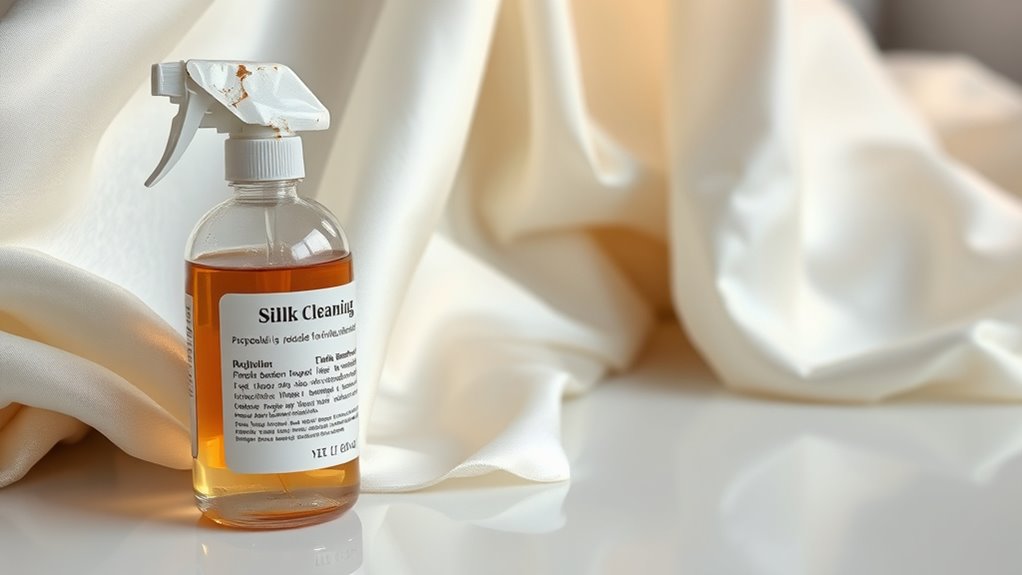
To guarantee your silk remains beautiful and durable, it’s essential to follow best practices for cleaning it safely and effectively. First, always opt for gentle, pH-balanced detergents specifically designed for silk. Second, avoid wringing or twisting the fabric—instead, gently hand wash or use a delicate cycle on your machine. Third, never expose silk to direct sunlight during drying; instead, lay it flat on a clean towel in a shaded area. Keep these tips in mind:
- Use cold water to prevent color fading and fabric damage
- Test any cleaning product on a small, hidden area first
- Avoid using bleach or harsh chemicals that can weaken fibers
Additionally, staying informed about AI safety measures helps ensure that cleaning technologies are reliable and effective. Following these steps helps preserve your silk’s luster, softness, and integrity over time.
Frequently Asked Questions
Can Homemade Cleaners Damage Silk Without Proper Ph Balance?
You might wonder if homemade cleaners can damage silk without proper pH balance. The answer is yes. If your homemade solution is too acidic or alkaline, it can weaken silk fibers, cause discoloration, or leave residues that attract dirt. Always test a small, hidden area first and use gentle, pH-neutral ingredients like mild soap and water. This helps protect your silk from potential damage caused by improper cleaning solutions.
Are There Natural Ph-Neutral Alternatives for Silk Cleaning?
Imagine giving your silk a gentle hug with a delicate touch—that’s what natural, pH-neutral cleaners do. You can try a mix of distilled water and a few drops of mild, natural soap or use a special silk-specific cleaner labeled pH-balanced. These options are kind to your silk, helping it stay soft and shiny without risking damage. Always test a small area first, and handle your silk with care.
How Long Does It Take for Silk to Show Damage After Improper Cleaning?
When you clean silk improperly, damage can appear surprisingly quickly or take months to show. Usually, if harsh chemicals or incorrect pH cleaners are used, you might notice discoloration, stiffness, or fabric weakening within weeks. Over time, continued exposure accelerates deterioration, leading to tears or loss of luster. To avoid this, always test cleaning products on a small area first and opt for gentle, pH-neutral solutions to preserve your silk’s beauty.
Do Commercial Ph-Balanced Products Guarantee Silk Safety?
You might think commercial pH-balanced products guarantee silk safety, but that’s not always true. While they’re formulated to be gentle, factors like concentration, application, and fabric type matter. Always test a small, hidden area first. Read labels carefully, and follow manufacturer instructions. If in doubt, consult a professional or opt for specialized silk cleaners. Relying solely on pH balance isn’t enough to guarantee your silk stays pristine.
Can Repeated Cleaning With the Wrong Cleaner Weaken Silk Fibers Over Time?
Think of silk as a delicate dance partner—you must treat it gently to keep it graceful. Repeated cleaning with the wrong cleaner can weaken silk fibers over time, much like a dance partner losing their strength with repeated missteps. Harsh chemicals break down the natural proteins, causing fibers to become brittle and fragile. So, yes, consistently using the wrong cleaner can gradually damage silk, compromising its beauty and longevity.
Conclusion
So, next time you reach for that “powerful” cleaner, remember: your silk’s delicate soul isn’t a fan of your cleaning crusade. Using the wrong pH can turn your luxurious fabric into a sad, shriveled mess faster than you can say “oops.” Treat your silk with respect, choose pH-balanced products, and avoid turning your wardrobe into a chemical disaster zone. After all, silk deserves a gentle touch, not a pH pummeling!
